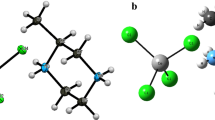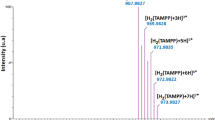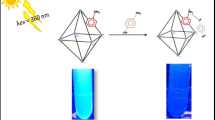Abstract
Spectroscopic, thermal and fluorescence properties of various thallium and tin complexes, X-Tl(III)t(4-Y)PP and X-Sn(IV)t(4-Y)PP where X = 5-SO3H-2-OHOC6H4,(5-SSA); 5-Cl-2-OHOC6H4,(5-CSA); and 5-NH2-2-OHOC6H4,(5-NSA) and Y = –Cl, –OCH3, are investigated in detail. Analysis of the spectral data [IR, UV–Vis and NMR (1H and 119Sn)] of complexes suggests that the two trans-axial ligands are strongly bound in a symmetric manner at the tin center in these complexes. Whereas the absorption and emission studies of thallium complexes characterized the sitting-Atop (SAT) feature of the complexes, the fluorescence lifetime of the tin complexes is found to be higher than thallium complexes. The structure and morphology of complexes were studied by X-ray powdered diffraction analysis. From the X-ray diffractograms, it could be revealed that the complexes are crystallized in mixed crystalline forms. Thermal studies of these porphyrins were carried out in an argon atmosphere from room temperature to 800 °C using thermal analyzer. Evaluation of the thermal analysis of the two metal complexes reveals that the tin(IV) porphyrin complexes are more stable than thallium(III) complexes. Some of the synthesized complexes of thallium and tin have been screened for biological activity against B. subtilis, M. luteus, S. aureus, P. florescens and E. coli by agar well diffusion methods that were found to be inactive against bacterial strains.
Graphical Abstract









Similar content being viewed by others
References
Auwarter W, Ecija D, Klappenberger F, Barth JV. Porphyrins at interfaces. Nat Chem. 2015;7:105.
Manke AM, Geisel K, Fetzer A, Kurz P. A water-soluble tin(IV) porphyrin as a bioinspired photosensitiser for light-driven proton-reduction. Phys Chem Chem Phys. 2014;16:12029.
Desbois N, Pacquelet S, Dubois A, Michelin C, Gros CP. Easy access to heterobimetallic complexes for medical imaging applications via microwave-enhanced cycloaddition. Beilstein J Org Chem. 2015;11:2202.
Calvete MJF, Simoes AVC, Henriques CA, Pinto SMA, Pereira MM. Tetrapyrrolic macrocycles: potentialities in medical imaging technologies. Curr Org Synth. 2014;11:1.
Rayati S, Nejabat F. Preparation of porphyrin nanoparticles: effect of bromine atom on the particle size and catalytic activity. Inorg Chem Commun. 2016;70:172.
Marijuan AF, Barandika G, Baza B, Urtiagaa M, Arriortua MI. Thermal stability and crystallochemical analysis for Co(II)—based coordination polymers with TPP and TPPS porphyrins. Cryst Eng Commun. 2013;15:4181.
Bogdan ML, Zgierski MZ, Bischoff C, Li M, Hu MY, Zhao J, Martin SW, Alp EE, Scheidt WR. Quantitative vibrational dynamics of the metal site in a tin porphyrin: an IR, NRVS, and DFT study. Inorg Chem. 2013;52:9948–53.
Gharaati S, Moghadamb M, Tangestaninejad S, Mirkhani V, Mohammadpoor-Baltork I, Barati B, Sadegh F. High-valent tin(IV) porphyrins: efficient and selective catalysts for cyclopropanation of styrene derivatives with EDA under mild conditions. J Organomet Chem. 2013;741–742:78–82.
Chen Y, Li A, Huang ZH, Wang LN, Kang F. Porphyrin-based nanostructures for photocatalytic applications. Nanomaterials. 2016;6:51.
Valicsek Z, Horvath O. Formation, photophysics and photochemistry of thallium(III) 5,10,15,20-tetrakis(4-sulphonatophenyl)porphyrin: new supports of typical sitting-atop features. J Photochem Photobiol A Chem. 2007;186:1.
Horvath O, Huszank R, Valicsek Z, Lendvay G. Photophysics and photochemistry of kinetically labile, water-soluble porphyrin complexes. Coord Chem Rev. 2006;250:1792.
Valicsek Z, Horváth O, Lendvay G, Kikaˇs I, Škorić I. Formation, photophysics, and photochemistry of cadmium(II) complexes with 5,10,15,20-tetrakis(4-sulfonatophenyl) porphyrin and its octabromo derivative: the effects of bromination and the axial hydroxo ligand. J Photochem Photobiol A Chem. 2011;218:143–55.
Valicsek Z, Horvath O, Patonay K. Formation, photophysical and photochemical properties of water-soluble bismuth(III) porphyrins: the role of the charge and structure. J Photochem Photobiol A Chem. 2011;226:23.
Ren DM, Guo Z, Du F, Liu ZF, Zhou ZC, Shi XY, Chen YS, Zheng JY. A novel soluble tin(IV) porphyrin modified single-walled carbon nanotube nanohybrid with light harvesting properties. Int J Mol Sci. 2008;9:45.
Kim HJ, Park KM, Ahn TK, Kim SK, Kim KS, Kim D, Kim HJ. Novel fullerene-porphyrin-fullerene triad linked by metal axial coordination: synthesis, X-ray crystal structure, and spectroscopic characterizations of trans-bis([60]fullerenoacetato)tin(IV) porphyrin. Chem Commun. 2004;. doi:10.1039/b411482.
Bajju GD, Katoch S, Devi G, Kundan S, Ashu K, Bhagat M. Synthesis and characterization of some new thallium(III) macrocyclic complexes and their biological studies. Main Group Met Chem. 2016;39:19.
Shetti VS, Ravikanth M. A simple alternative method for preparing Sn(IV) porphyrins. J Porphyr Phthalocyanines. 2010;14:361.
Chandraleka S, Chandramohan G. Afr J Pure Appl Chem. 2014;8:162.
Rahimi R, Fard EH, Saadati S, Rabbani M. Degradation of methylene blue via Co–TiO2 nano powders modified by meso-tetra(carboxyphenyl) porphyrin. J Sol-Gel Sci Technol. 2012;62:351.
Miao L, Jin P, Kaneko K, Terai A, Gabain NN, Tanemura S. Preparation and characterization of polycrystalline anatase and rutile TiO2 thin films by rf magnetron sputtering. Appl Surf Sci. 2003;212:255.
Francisco MSP, Mastelaro VR. Inhibition of the anatase–rutile phase transformation with addition of CeO2 to CuO–TiO2 system: Raman spectroscopy, X-ray diffraction, and textural studies. Chem Mater. 2002;14:2514.
Major MM, Horvath O, Fodor MA, Fodor L, Valicsek Z, Gramp G, Wankmüller A. Photophysical and photocatalytic behavior of nickel(II) 5,10,15,20-tetrakis(1-methylpyridinium-4-yl)porphyrin. Inorg Chem Commun. 2016;73:1.
Horvath O, Valicsek Z, Harrach G, Lendvay G, Fodor MA. Spectroscopic and photochemical properties of water-soluble metalloporphyrins of distorted structure. Coord Chem Rev. 2012;256:1531.
Acknowledgements
We would like to acknowledge Indian Institute of Technology, Mandi, Himachal Pradesh, for photoluminescence studies and IIIM, Jammu, for their UV–Vis. studies. We thank University Grant Commission, New Delhi, for their support. We also thank IISC, Bangalore, for the NMR studies.
Author information
Authors and Affiliations
Corresponding author
Rights and permissions
About this article
Cite this article
Katoch, S., Bajju, G.D., Devi, G. et al. Synthesis, thermoanalytical and spectroscopic characterization of newly synthesized macrocyclic complexes of thallium(III) and tin(IV). J Therm Anal Calorim 130, 2157–2165 (2017). https://doi.org/10.1007/s10973-017-6531-x
Received:
Accepted:
Published:
Issue Date:
DOI: https://doi.org/10.1007/s10973-017-6531-x




